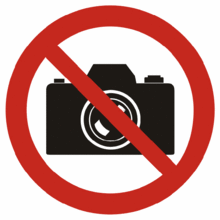Museums Should Always Allow Photography
Published on April 30, 2015 (↻ February 5, 2024), filed under Design (RSS feed for all categories).
Side note. I much appreciate museums and have during my long journey around the world alone visited enough to ever want again. A hobby photographer, I like to take photos in these places; alas, there are still too many that prohibit taking any. Here my view on why photography in museums should always be allowed, and just as much in art galleries and like institutions.

Figure: No to the no.
Why Allow Photography?
There are three good reasons for why museum photography should be allowed.
-
For visitors, photos are a great way to remember places and works, and to research them if so inclined.
-
For museums and rights holders (and comparable institutions), photography amounts to free, legitimate advertising.
-
Generally speaking, photography helps to… solidify and promote culture. (Whether that is always so desirable is another matter.)
Or, Why Not Ban Photography?
For all the reasons above, which can’t be in our interest.
I find, however, that prohibiting photography is quite offensive to visitors; it treats them as suspects to engage either in criminal (copyright violations) or anti-social conduct (distracting people).
What Else?
Most notably, flash photography and professional equipment appear to be sound exceptions for they can either distract other visitors or damage exhibition pieces, or may actually facilitate the so loathed copyright violations.
For alternatives, if museums are so afraid of rights being disregarded, or are at such loss when it comes to how to increase store sales, they could look into selling special photography tickets. (I’ve observed several museums in Asia take this course, and it seemed effective.)
❧ I for my part have begun to avoid places that don’t allow photography. I don’t like to be so sure of my memories of place and pieces to fade, and I’m not amused by the proposition to swap lightweight digital photos for heavy, expensive museum store coffee table books.
I wrote this to collect the thoughts I had when repeatedly running into “no photography” signs, so that they may lend themselves to build a stronger case. Not all in our culture is worth preserving, but what is should not be made artificially inaccessible and scarce. Too, I suppose.
About Me

I’m Jens (long: Jens Oliver Meiert), and I’m a web developer, manager, and author. I’ve worked as a technical lead and engineering manager for small and large enterprises, I’m an occasional contributor to web standards (like HTML, CSS, WCAG), and I write and review books for O’Reilly and Frontend Dogma.
I love trying things, not only in web development and engineering management, but also in other areas like philosophy. Here on meiert.com I share some of my experiences and views. (I value you being critical, interpreting charitably, and giving feedback.)
Comments (Closed)
-
On April 30, 2015, 16:00 CEST, Vadim Makeev said:
There’s “Photography Allowed” sign developed by Art. Lebedev Studio, I see it more and more recently in Russian museums: http://www.artlebedev.com/everything/photo-ok/
Read More
Maybe of interest to you, too:
- Next: Business Practices, Reframed
- Previous: 10 Photos
- More under Design
- More from 2015
- Most popular posts
Looking for a way to comment? Comments have been disabled, unfortunately.

Get a good look at web development? Try WebGlossary.info—and The Web Development Glossary 3K. With explanations and definitions for thousands of terms of web development, web design, and related fields, building on Wikipedia as well as MDN Web Docs. Available at Apple Books, Kobo, Google Play Books, and Leanpub.
